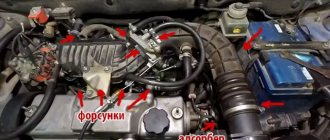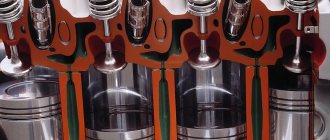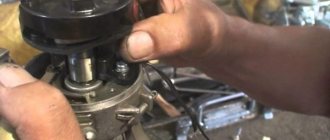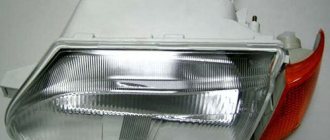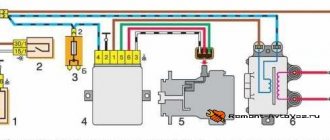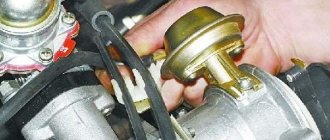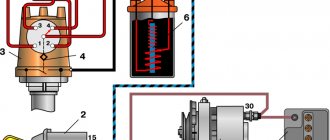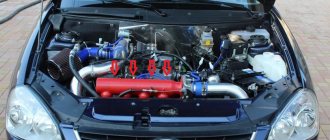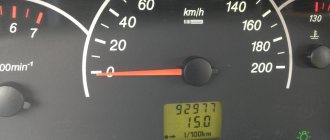Determining and decoding errors on the VAZ 2114
Self-diagnosis of a car allows you to identify faults, but some of them are rarely identified. An odometer is used for diagnostics.
Self-diagnosis of VAZ 2114
The sequence of actions is as follows:
- Press and hold the odometer button and turn the ignition key to the first position.
- Release the odometer button and press briefly again. As a result, the firmware version will be displayed.
- Now, to see the error codes, you need to press and release the odometer button again.
Error codes are in the form of numbers from 1 to 9 and two-digit numbers, unlike those displayed by the on-board computer. Thus, you can use the odometer to identify some car faults. The most common errors are shown in the table below.
Error codes for VAZ 2114 injector 8 valves: table
| Code | Description of the error |
| 1 | Microprocessor malfunctions |
| 2 | Problems with the fuel level sensor |
| 4 | Exceeding the permissible voltage in the electrical network |
| 8 | Mains voltage too low |
| 13 | No signal from the oxygen sensor |
| 14 | Very high signal level of the coolant temperature sensor |
| 15 | Coolant temperature sensor signal very low |
| 16 | High voltage in the on-board network |
| 17 | Low voltage in the on-board network |
| 19 | Problems with the crankshaft position sensor signal |
| 24 | Malfunctions in the speed sensor |
| 41 | Incorrect phase sensor signals |
| 51, 52 | Problems with the ROM and RAM of the device, respectively |
| 53 | CO potentiometer does not work |
| 61 | Problems with the lambda probe sensor |
Diagnosis of faults using special equipment
To identify faults, service stations usually use the car’s on-board computer and a laptop with specialized applications. In this case, it is possible to obtain error codes that correspond to various problems. The most common of them are shown in the table.
Code Description of error P0102, P0103 The mass air flow sensor sends an incorrect signal. P0122, P0123 The throttle sensor provides incorrect information. P0130-P0134 There is a malfunction in the oxygen sensor or damage to the wiring connecting it to the system. P0201-P0204 Clogged or shorted injectors or broken wiring of their sensor. P0300 Problems with ignition (misfires). P0335, P0336 The knock sensor is not working properly. P0351, P0352 The ignition coils are not functioning correctly. When such error codes are displayed, the engine may “trouble.” This problem can also be signaled by errors P2301 and P2304. P0480 Cooling fan is not functioning. P0505, P0506, P0507 The idle speed sensor is faulty. P1602 There is no power supply to the on-board network (the most common error). P1689 Malfunctions in the on-board computer
Please note that in this case it will throw incorrect error codes.
If errors occur with other codes, you should read the information about them in the file that comes with the car diagnostic application, or search on the Internet.
The controller clears the memory after turning off the engine with the ignition and disconnecting power from the battery for 10-15 seconds. In this way, you can determine after repair whether the malfunction has been eliminated.
Errors in the VAZ 2114 occur quite often, so the ability to recognize them will not be superfluous to carry out proper car repairs. For correct diagnosis, you will need a computer with a special program and an understanding of the on-board computer readings.
Online consultation
Error p0113
A three-way catalytic converter is used to control the exhaust emissions of hydrocarbons (HC), carbon monoxide (CO), and nitrogen oxide (NOx). The catalyst in the converter accelerates the chemical reaction of oxidation of HC and CO in the exhaust gas, turning them into harmless vapors of water and carbon dioxide. It also reduces NOx by converting it to nitrogen. The catalytic converter can also store oxygen. The ECM can monitor this process using the heated oxygen sensor (HO2S2), located in the exhaust stream after the catalytic converter. The HO2S2 sensor produces a signal that indicates the amount of oxygen catalyst, which in turn indicates the ability to effectively neutralize exhaust emissions. The ECM monitors the performance of the converter by allowing it to warm up first, allowing it to cool down while the engine is idling, and then increasing or eliminating excess fuel by monitoring the response of the HO2S2 sensor. During normal operation of the converter, the response of the HO2S2 sensor to an excessive fuel content is sequentially compared with the HO2S1 sensor. If the response of the HO2S2 sensor is similar in level to the response of the HO2S1 sensor, then the amount of oxygen catalyst or the performance of the converter is perceived as insufficient and the malfunction indicator lamp (MIL) lights up. Conditions for Setting the DTC The vehicle is operating in closed loop mode. Engine coolant temperature (ECT) is above 78°C (172.4°F). Mass air flow ranges from 15 to 30 kg/hour. Engine speed ranges from 1792 to 2304 rpm. Vehicle speed ranges from 45 km/h to 56 km/h. The deviation in air flow is less than 10 kg/hour. Predicted catalytic converter temperatures range from 300°C (572°F) to 800°C (1472°F). The engine runs for more than 60 seconds. There are no DTCs related to the HO2S sensor, misfire, coolant temperature sensor, crankshaft position sensor, camshaft position sensor, vehicle speed sensor, manifold air temperature sensor, throttle position sensor, IAC actuator, EGR valve, fuel trim or CAN bus communication. Conditions for setting the DTC. The HO2S2 filter signal value is greater than 101. Action Taken When the DTC Sets The malfunction indicator lamp illuminates. The controller records the operating conditions at the time the fault is detected. This information is stored in a status record buffer and fault logs. An archive of diagnostic trouble codes is saved. Conditions for Clearing the DTC/Malfunction Indicator The DIL turns off after three consecutive test cycles have completed without failure. The historical DTC clears after 40 heat cycles without failure. The DTC can be cleared by a scan tool. Diagnostic Aids The converter test may stop due to changes in engine load. While checking the converter, do not change the engine load (ie battery, cooling fan, heater motor). An intermittent malfunction can be caused by a weak connection, frayed insulation, or broken wiring in the insulation. Any circuit that may be causing an intermittent fault should be carefully inspected for the following: Removed terminals Terminal connections Faulty locks Warped Damaged terminals Loose connections between terminals and wires.
FakeHeader
Comments 41
Error p0327
Here's what to do if the spark plugs are changed 3-4t.km. back (to maintenance) When the problem arose for the first time, they changed the coil in the second cylinder, but after 3 days the problem came out again - they cleaned all the injectors, replaced the fuel filter, but after 3 days the same problem again...
does the CHECK appear on the dashboard?
Yes, it appears when starting it cold and warming up for a couple of minutes and there it is. I turned it off, started it, and it seemed to be running fine. It started even without checks, it just started and stalled right away, there were still frosts (automatic start), it started again normally. Then it started to start and stalled not immediately, but after some time (also with autostart) it was back to normal. Then I started it with the key - and saw a check; when I start it again, it disappears. The check came out about 10 minutes later, everything was fine again. And it simply stalled in traffic. Well, here’s the fun part - pp.userapi.com/c639719/v6...444/44518/bajmD9S-lkk.jpg The tidy allows you to connect an external temperature sensor, but of course I don’t have one, and I was very surprised. There are two options - either -40 or points
1) Regarding the temperature sensor, not all trim levels have it. Buy and connect) What is the error number?
2) Regarding the stalling, this is a jamb of the factory firmware, specifically for Grants with automatic transmission. Here is an excerpt from the Za Rulem magazine article “The same Jatco JF414E automatic machine works on the Grant and the mi-DO hatchback. The editorial mi-DO made me suffer: sometimes when braking or even in leisurely walking mode, the engine suddenly stalled. To restart it, it was necessary to put the machine into “parking”, and this can only be done by stopping completely! The reason for the vagaries lay in the fact that initially the engine calibrations were calculated for the version with a manual transmission, but for a car with an automatic transmission they were not the best fit: the mechanical losses of the transmission were not taken into account, which are much higher in hydromechanics. ————-We managed to push through solution to the problem at the factory level: a diagnostic unit was installed in the editorial car, which we drove with for several months. Decryption made it possible to catch errors, and mi-DO received new firmware for the engine control unit. Now this program has gone into series: with its appearance, other unpleasant symptoms of automatic Datsuns have disappeared. The engine speed no longer drops during heavy braking, and the cramps that shook the car when the air conditioning was turned on have disappeared.”
How to resolve error code P0363?
A good starting point is always to check the technical service bulletins (TSB) for your specific vehicle.
Your problem may be a known problem with a known fix released by the manufacturer and could save you time and money during diagnosis. A diagnostic scanner and an accurate source of vehicle data (like all DIY data) will be needed to diagnose the P0363 code. Since the P0363 code is essentially a reaction to a stored cylinder misfire code, you will need to diagnose all stored cylinder misfire codes (P0301-p0312) before attempting to diagnose this code. While there are numerous tools designed to test ignition coil, spark plug, and fuel injector function, the simple method of replacing components between cylinders has proven effective for me for more years than I care to admit. This is not always possible with fuel injectors, but works well with ignition coils and spark plugs, which fail much more often than fuel injectors. For more tips on diagnosing cylinder misfire codes, see the appropriate entry in OBD II codes. You will still need a scanner to retrieve the stored codes and freeze the frame data. The scanner is also used to clear codes after you have written them down for reference as the diagnostic process continues. After completing these steps, clean up the codes and start exchanging components for testing purposes. Obviously, spark plugs will need to be replaced in sets if the vehicle is near the recommended replacement interval. However, locate the faulty part before performing any maintenance. When replacing the ignition coil for a specific cylinder, it is recommended that the spark plug be replaced (unless the spark plugs have recently been replaced). This will save you time in the long run. The problem that creates a ton of confusion is that when some technicians discover that there is no ground pulse for the cylinder in question, they treat it as a fault instead of a reaction (caused by the PCM) to a misfire. This can leave you chasing your tail if you are not familiar with the fuel cut-off system found on some models. If p0363 is stored without any cylinder misfire codes, suspect a defective PCM or a PCM programming error. Additional diagnostic notes: code P0363 must be cleared before the ground pulse is restored to the injector for the cylinder in question When using the swapping method to test spark plugs, use caution when removing plugs from aluminum cylinder heads. Threads (in aluminum) are very fragile and can be damaged if not allowed to cool properly. This article uses machine translation.
On which cars is this problem most common?
The problem with code P0171 can occur on different machines, but there are always statistics on which brands this error is most often present. Here is a list of some of them:
- Audi (Audi a3, Audi a4, Audi a6, Audi q5)
- BMW (BMW X3, BMW X5, E39, E46, E53, E60, F10)
- Cadillac (Cadillac SRX)
- Chery (Chery Amulet)
- Chevrolet (Chevrolet Aveo, Camaro, Captiva, Cobalt, Cruz, Lacetti, Silverado, Spark, Trailblazer, Epica)
- Chrysler (Chrysler Voyager, PT Cruiser, Sebring)
- Citroen (Citroen C4)
- Daewoo (Daewoo Gentra, Lanos, Matiz, Nexia)
- Dodge (Dodge Caravan, Ram, Stratus)
- Fiat (Fiat Albea)
- Ford (Ford Galaxy, Kuga, Maverick, Mondeo, Taurus, Focus, Fusion, Expedition, Explorer, Escape, F-150)
- Honda (Honda Accord, Pilot, SRV, Fit, Civic)
- Hover
- Hummer H3
- Hyundai (Hyundai Getz, Santa Fe, Sonata, Tucson, Elantra)
- Infiniti (Infiniti fx35)
- Isuzu (Isuzu Rodeo)
- Jaguar
- Jeep (Jeep Grand Cherokee)
- Kia (Kia Carnival, Rio, Sid, Sorento, Spectra, Sportage, Cerato)
- Land Rover (Land Rover Range Rover, Freelander)
- Lexus (Lexus gx470, ls430, lx470, rx300, rx330, rx350)
- Lifan (Lifan x60)
- Mazda (Mazda 3, Mazda 6, Mazda cx5, Mazda cx7, Demio, Premasi, Tribute, Surname, MPV)
- Mercedes (Mercedes w203, w211)
- Mitsubishi (Mitsubishi Outlander, Galant, Delica, Lancer, Montero, Pajero)
- Nissan (Nissan Avenir, Hell, Almera, Bluebird Silphy, Vingroad, Beetle, Qashqai, Cube, Maxima, March, Micra, Murano, Note, Primera, Sunny, Serena, Teana, Tiida, X-Trail)
- Opel (Opel Antara, Astra, Vectra, Zafira, Insignia, Corsa, Meriva, Mokka)
- Peugeot (Peugeot 207, 307, 308, 408, Partner)
- Pontiac (Pontiac Vibe, Montana)
- Ravon (Ravon P4)
- Rover
- Saab
- Seat
- Skoda (Skoda Yeti, Octavia, Superb, Fabia)
- Ssangyong (Sangyong Kyron)
- Subaru (Subaru Outback, Impreza, Legacy, Tribeca, Forester)
- Suzuki (Suzuki Vitara, Grand Vitara, Ignis, Liana, Swift, sx4)
- Toyota (Toyota Avensis, Auris, Vitz, Vish, Ipsum, Camry, Corolla, Land Cruiser, Matrix, Passo, Platz, Prado, Prius, Rav4, Celica, Sienna, Tundra, Fielder, Funcargo, Highlander, Estima, Yaris)
- Volkswagen (Volkswagen Bora, Golf, Jetta, Caddy, Passat, Polo Sedan, Touareg, Tiguan)
- Volvo (Volvo s40, s60, s80, xc90)
- VAZ 2107, 2109, 21099, 2110, 2112, 2114, 2115
- Volga Cyber
- Gazelle
- Lada Vesta, Granta, Kalina, Largus, Niva, Priora
- Tagaz Tager
- UAZ Bukhanka, Patriot, 409
With fault code P0171, you can sometimes encounter other errors. The most common ones are: P0100, P0106, P0130, P0131, P0132, P0134, P0137, P0172, P0174, P0175, P0300, P0302, P0303, P0327, P0420, P0422, P0441, P1101, P1130, P201 5, P2187, P2195, C1201 , U1001.
Lada Granta errors P0363 P1304
#1 Rexis
Users
4 messages
Car make: Lada Granta
Lada Granta 2012 standard 183 8-valve engine.
I started the “warm” car, it started to stall, became dull when accelerating, didn’t pick up from the bottom, and responded very sluggishly to the gas pedal. I got to the garage and threw in a scanner: errors P0363, P0301, P0038. Replaced spark plugs, high-voltage wires, ignition coil. I reset the errors. The result is the same - it crashes, doesn’t drive, the check light flashes again. I spat and left it without the “+” terminal overnight.
The next day the following errors appeared: P0304, P0363, i.e. misfires and lack of fuel supply have already passed to the 4th cylinder.
Actually, where to dig now?
I haven’t changed the fuel filter for a long time, maybe that’s why it looks like this? Either the brain caught a glitch, because... Before all this, the day before, the alarm started to go off on its own (Panther, IMMO is not activated)?
Post edited by Rexis: 12 April 2021 - 08:26
#2 Practitioner
VIP Member
6,637 messages
- Car make: VAZ0, (VAZ 11173, VAZ 21074-30-11)
- From: Novosibirsk
Diagnostics must be done normally, analysis.
0038 - isolate the DK2 wires from the metal, most likely a short circuit.
The rest is misfires: either the fuel supply (pump, injectors, filters), or the electrical part (spark plugs, wires), or iron (wear of the CPG, valve, etc.).
#3 Rexis
Users
4 messages
Car make: Lada Granta
Diagnostics must be done normally, analysis.
0038 - isolate the DK2 wires from the metal, most likely a short circuit.
The rest is misfires: either the fuel supply (pump, injectors, filters), or the electrical part (spark plugs, wires), or iron (wear of the CPG, valve, etc.).
Cool advice. The main thing is practical and vital.
Despite the fact that the post already describes some of the operations. At a minimum, these are not PLUGS, NOT WIRES and not an ignition coil.
As for error 0038. It pops up like a trailer. The same thing happened when the brake pedal position sensor was faulty.
VIP Member
2,879 messages
Description and meaning of error P0363
This diagnostic trouble code (DTC) is a generic powertrain code, which means it applies to OBD-II equipped vehicles (BMW, Mini, Mazda, Ford, Hyundai, Chevrolet, etc.). While general, specific repair steps may vary depending on the make/model. When I detect a stored P0363 code, I immediately know that the powertrain control module (PCM) has detected a misfire and has disabled the fuel injector for the affected cylinder. I can also say with relative certainty that this vehicle is of European origin. The PCM monitors changes in input signals from the crankshaft position sensor (CPS) and camshaft position sensor/s (CMPS) to determine if misfire is present, as well as which cylinder is misfiring. Initially, when a misfire is detected, the Malfunction Indicator Light (MIL) may flash rapidly for a period of time and stop (instead of remaining on). The purpose of a flashing MIL is to make the driver aware that current driving conditions, combined with cylinder misfire, may cause damage to the catalytic converter. Regardless of the flashing MIL, the misfire code must be stored, although it may be stored as a pending code. In some vehicles (usually European grade), when the PCM detects multiple ignition cycles with a misfire code, it will cut off the fuel supply to the corresponding cylinder. This is typically achieved by turning off the ground pulse to the fuel injector for that particular cylinder. It is recommended to cut off the fuel supply to a particular cylinder as excessive fuel may cause catalytic converter failure. However, for a new technician, this can also lead to confusing testing. For more information about why this occurs, see the troubleshooting section. If a misfire is detected, a cylinder misfire code is stored and the fuel supply to the corresponding cylinder is turned off, a P0363 code is stored and the MIL is illuminated. One or more cylinder misfire codes usually accompany this code. Other misfire codes include P0300, P0301, P0302, P0303, P0304, and others.
What does code P0363 mean?
OBD II Trouble Code P0363 is a generic code that is defined as "Misfire Detected - Fuel Disabled" and is set when the PCM (Powertrain Control Module) detects a misfire in one or more cylinders and cuts off the fuel supply to the misfire cylinder ( s ) to protect the catalytic converter(s)
Please note that while this code is usually accompanied by misfire related codes which identify the misfiring cylinders, other codes may also be present such as fuel pressure, ignition or engine sensor codes which may identify the cause of the misfire
It should be noted that the P0363 code serves a dual purpose: the first is to indicate a misfire in one or more cylinders (albeit without specifying the misfire cylinder(s)) and the second is to disable the fuel injectors in the misfire cylinder(s) when installed code to protect the catalytic converter(s).
Regardless of the cause of the misfire, misfire results in very small variations in crankshaft speed, and modern engine management systems use input from the crankshaft position sensor to detect these changes. However, in practice, a misfire means that the fuel in the affected cylinder(s) does not burn or does not burn completely, and the unburned fuel is expelled through the exhaust valves into the exhaust system on the exhaust stroke of the affected cylinders.
However, when unburned fuel passes through the already very hot catalytic converter, the heat in the converter ignites the fuel, causing the catalytic converter to reach temperatures that are high enough to melt the converter in ten seconds or less unless the PCM turns off the fuel supply into cylinders with misfires. To make matters worse, overheated catalytic converters are among the top ten reasons why cars catch fire, and so many cars are destroyed this way.
It should also be noted that while misfiring cylinders will be disabled on most European-made vehicles, this feature is less common on American-made vehicles, which means that this code (usually indicated by a flashing red warning light) should NOT be ignored. and SHOULD be investigated and resolved at the earliest opportunity, if not immediately. Failure to comply with this code on an American-made vehicle may result in a fire, which can be fatal.
What does P0363 mean?
To detect misfires, the PCM uses data from the crankshaft and camshaft position sensors and also takes into account the number of engine revolutions per minute. If the PCM detects that the camshaft or crankshaft position has changed and is abnormal under current conditions, or that the actual engine speed is not at the required value, it will assume that one of the engine cylinders is misfiring. In this case, the PCM will cut off fuel to that cylinder and store P0363.
Troubleshooting
If during diagnostics an error 0363 of a VAZ 2114 is noticed, then the reasons for this may be the following:
- Poor quality fuel.
- Air intake leaking.
- No spark.
- Damage or wear to the cylinders.
The first of these problems is quite simple to solve - you should try to refuel with gasoline from other manufacturers, and not the one that is currently used. Despite its apparent simplicity, this method very often helps - after all, as statistics show, more than half of the cases of error 0363 are associated with low-quality fuel.
Gasoline for VAZ 2114
If replacing the fuel does not help and the troubles continue, you should check the air intake system. It is necessary to tighten all fastening clamps, replace the air filter if it is worn out, and also measure the pressure in the ramp (normally it does not exceed 2.8 atmospheres).
Fuel pump pressure
The next step in troubleshooting will be diagnosing the ignition system.
So, you will need to check:
- the condition of the armored wire connecting to the faulty cylinder;
- condition of the spark plug of a faulty cylinder;
- presence of oxides at connection points.
Checking high-voltage wires with a tester
In order to check the condition of high-voltage wires, you need to measure their resistance with a tester. Normally it should not be more than 10 kOhm. If the measurements show greater resistance, then the wires are faulty and should be replaced (this should be done even if a regular “continuity test” shows the presence of a working circuit).
Plaque on the spark plug body
If the wires are in good condition, then you should check the spark plugs, or better yet, replace them with new ones, especially if the ones already installed belong to the “budget” price segment (as you know, all four spark plugs should be replaced at once, and not just one faulty one).
Compression measurement for VAZ 2114
If all the above steps did not help, all that remains is to check the condition of the cylinders themselves. To do this, you should measure their compression. Its difference among all four cylinders should not exceed 0.5 atmospheres. If in some cylinder it differs significantly (both up and down), the car should be taken to a car service center to diagnose the engine condition.
How to resolve error P0336?
Here's a step-by-step guide on how a professional auto mechanic will diagnose a P0336 trouble code. You can complete these steps yourself.
Connect your car charger
Before you begin diagnosing the P0336 code, make sure the car charger is connected. This is necessary to ensure that the battery does not discharge, which can lead to additional fault codes.
Connect OBD2 scanner
An OBD II scanner is a diagnostic and scanning tool that reads the information contained in the trouble code. The scanner can be of two types - a regular device for reading error codes or for advanced scanning.
We recommend using the advanced scanner as it can also record data.
Connect the scanner to the OBD2 diagnostic port and read all stored trouble codes and freeze frame data (if any). This information may help if the fault appears to be intermittent.
Visual inspection
Start by visually inspecting all associated wiring harnesses and connectors
Pay attention to wires, sensors, and connectors that are contaminated with engine oil, coolant, or power steering fluid. Petroleum-based fluids are known to corrode wiring insulation and cause shorts or open circuits and possibly cause P0336.
Checking the sensor resistance
Typically there should be three wires on the sensor - positive, ground and a signal to the ECU. This is the basic diagram. There may be other output circuits, so check the wiring diagram for your vehicle. Using a multimeter, check them.
Most cars use 5 volts. If the reference voltage and ground circuit are within specification, proceed to the next step.
Disconnect the electrical connector from the DPKV and test it according to the manufacturer's recommendations using a multimeter. Replace the sensor if the sensor resistance values do not meet the manufacturer's specifications. If all CPCV circuit resistance values are consistent with the manufacturer's documentation, proceed to the next step.
Checking with an oscilloscope
Connect the crankshaft sensor. Connect the positive test lead of the oscilloscope to the signal wire of the DPCV wiring harness, and the negative lead to the CPCV ground. Select the appropriate voltage setting on the oscilloscope and turn it on.
With the transmission in park or neutral and the engine idling (or cranking), observe the waveform on an oscilloscope. Focus on unexpected peaks or glitches in the signal waveform.
If you notice spikes, gently wiggle the wiring harness and sensor connector while looking at the waveform. Try to determine if the problem is a weak connection or a faulty PDAC
Also look for missing voltage blocks in the waveform. This may indicate wear or damage to the crankshaft timing belt pulley.
Also check the magnetic tip of the DPKV for metal debris and clean it if necessary. If the waveform is normal, proceed to the next step.
Reconnect the oscilloscope test leads to the same circuits on the ECU connector and observe the waveform. If changes are detected in the signal shape relative to when the test leads were connected near the sensor, then there is an open circuit or short circuit between the DPKV connector and the control unit connector. If the waveform here is the same as the crankshaft sensor connector, proceed to the next step.
Wiring check
Disconnect the connectors from all relevant controllers and begin testing individual circuits with a multimeter. Failure to disconnect may damage the ECU. Shorted or open circuits must be repaired or replaced.
If no breaks or short circuits are detected, then there is a defect in the firmware of the control unit.
How does a mechanic diagnose a P0363 code?
The mechanic will first visually inspect and, if necessary, repair or replace all loose, frayed, shorted, damaged or corroded wires, connectors and other electrical components. He will then clear the error codes from the PCM memory and test drive the vehicle to see if P0363 appears again. If the error code appears again, the mechanic will continue to diagnose. It will perform diagnostics until it finds a problem.
What repairs can fix the P0363 code?
After detecting the P0363 code using an OBD-II scanner and checking all electrical components, the mechanic will do the following:
- Inspects and, if necessary, repairs or replaces worn or damaged ignition system components such as spark plugs, ignition coils, distributor cap, fuel filter, and related wires.
- Replace the appropriate spark plug and ignition coil on a cylinder that is working properly to determine which component is faulty.
- Takes oxygen sensor readings to determine if a vacuum leak is present and, if necessary, repairs or replaces a worn or damaged vacuum hose.
- Check and, if necessary, clean the clogged catalytic converter
- Repairs or replaces a faulty fuel injector.
Each time a repair is performed, the mechanic will clear the error code from the PCM memory and retest the system to see if the P0363 Owl code still appears. This will help you find out if the problem is resolved.
Need help with error code P0363?
The company - CarChek, offers a service - on-site computer diagnostics; specialists from our company will come to your home or office to diagnose and identify problems with your car. Find out the cost and sign up for on-site computer diagnostics or contact a consultant by phone
Causes of error P0363
The most common cause of the P0363 code is a malfunction of one or more ignition system components. The problem may be worn or damaged spark plugs, ignition coils, and related wires.
Other reasons are:
- Insufficient fuel pressure
- Vacuum leak
- Malfunction in the exhaust gas recirculation system
- Fuel injector malfunction
- Clogged catalytic converter
Vesta error codes - decoding and designation
To properly understand the essence of the problem, you need to know how the serial error number is deciphered. The screen of a third-party device usually displays a five-digit code, where the first part is:
- B – body systems are damaged;
- C – interruptions in the stability of the suspension and chassis;
- P – incorrect functioning of the electronics of the power unit or gearbox;
- U – the data exchange bus is out of order.
Next comes the first digit:
- 0 – SAE catalog number;
- 1-2 – standard serial number;
- 3 – reserve.
The third part of the code directly indicates the system where the breakdown was detected:
- 1-2 – air or fuel supply devices;
- 3 – ignition;
- 4 – catalyst problems;
- 5 – incorrect idle speed;
- 6 – problems with the computer;
- 7-8 – gearboxes for automatic or manual.
The last element of the code indicates the serial number of the error.
Errors p0363 and p1304
You can detect these errors if you use a self-diagnostic adapter. Each of them has its own decoding and provides the car owner with certain information about the breakdown that occurred in the car. So, the number 0363 (error code) on 2114 indicates that misfire occurred in one of the engine cylinders and the supply of the fuel mixture to it was stopped.
In most modern cars, an electronic control system automatically stops the flow of fuel to the cylinder if any problems occur in it.
The next error - 1301...1304 indicates that in a specific cylinder (the number of which is equal to the last digit in the error number) there were ignition delays, which are critical for the converter.
Often these errors are accompanied by errors of type 0300 - exceeding the threshold of danger (toxicity) of the exhaust as a result of misfire.
How to diagnose and reset error codes?
In addition to the instrument panel, in Lada Kalina you can diagnose a controller that monitors the functioning of a specific electronic component of the LADA Kalina car. For example, the Bosch-ME-7.9.7 controller is capable of informing about the presence of an engine error. Reference books or a special program will help you decipher the meanings of the codes. Mechanics remember the interpretation of all codes by heart, but beginners and owners with a similar desire have only to step on the path of an amateur diagnostician.
More specifically about some code examples:
- error “0441” indicates a malfunction of the oxygen sensor;
- code “1602” will indicate a loss of voltage in the ECU power circuit;
- error “0363” will inform you about a coil failure.
The nature of the autonomous diagnostic module is such that the breakdown of a specific part is not displayed, but a specific area is localized, in which the owner needs to solve the existing problems through more accurate diagnostic measures and subsequent repairs. Many car owners will find a table of codes and their decoding useful.

